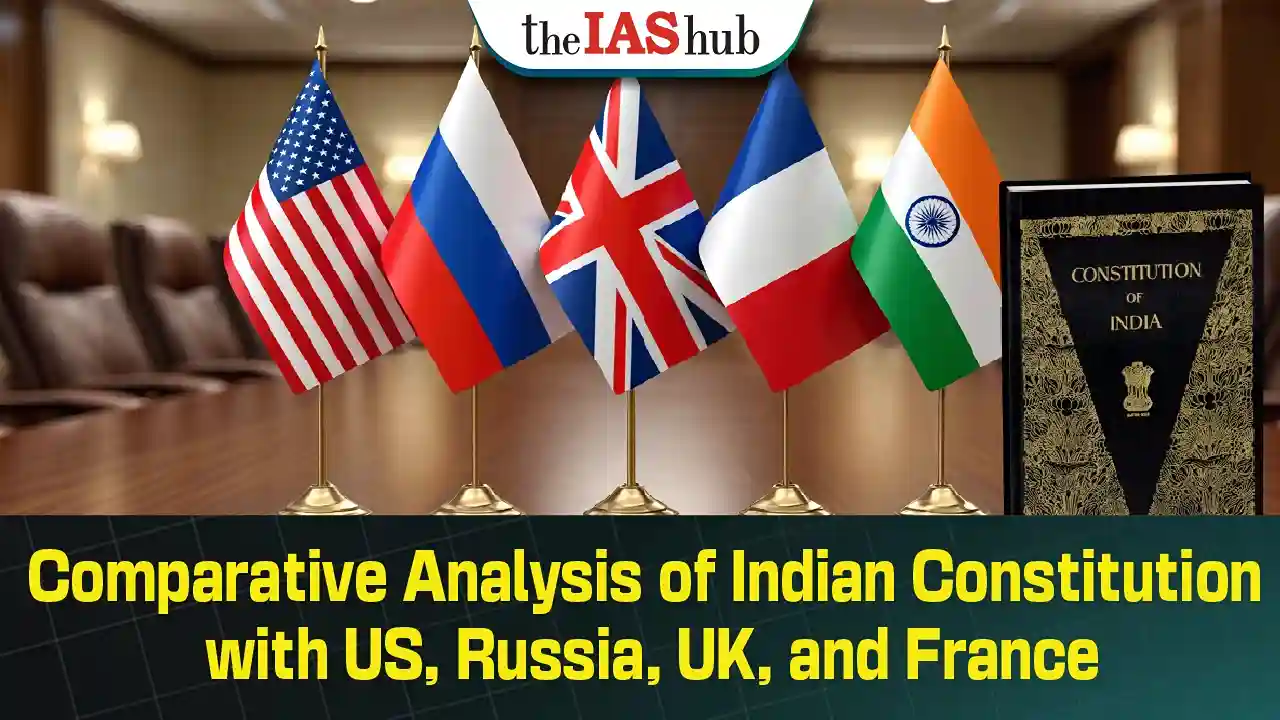Explore the Comparative Analysis of the Indian Constitution with those of the US, Russia, UK, and France. Learn key similarities and differences in governance, federalism, rights, judicial systems, amendments, and political frameworks.


The Indian Constitution is a dynamic and comprehensive document that draws inspiration from various global democratic models. In crafting its legal and institutional framework, India borrowed significant features from nations like the United States, Russia, the United Kingdom, and France. Each of these countries contributed distinctive elements—such as federalism, parliamentary systems, separation of powers, and rights-based jurisprudence—which were adapted to suit India's unique socio-political context. This comparative analysis highlights the similarities and differences in structure, philosophy, and governance between the Indian Constitution and those of the US, Russia, UK, and France.
India-USA
|
Similarities
Legislative framework:
Philosophical elements.
|
Differences Amenability of Constitution: India's constitution is both rigid and flexible, in contrast to the USA's rigid structure. Political framework: India has a parliamentary system of governance, whereas the USA has a presidential one. Setup for President:
Office of the Vice-president: USA: Because of a vacancy in the office of the President, a Vice President may become President.
Fundamental rights:
Checks and Balances:
Judicial structure:
Federalism:
|
India - Russia
|
Similarities Setup for executives: In both nations, the President appoints the prime minister. Legislative framework: Similar to India, the Lower House is more powerful. Both of them include a clause outlining essential rights. |
Differences
|
India – UK
|
Similarities
|
Differences Constitution: Written/Unwritten:
Political framework: India is a Republic, whereas the United Kingdom is a constitutional monarchy. In India, the Prime Minister may come from either House of Parliament, unlike the UK, where he must be chosen from the lower House. Legislative framework:
Executive: The executive has individual legal responsibility. In India there is no individual legal responsibility. Amendment to the constitution
|
India – France
|
Similarities
|
Differences
|
CONCLUSION
India's constitution was designed to make the government efficient, fair, and responsible. It ensures government lawfulness. It ensures the government follows the proper legislative process when passing or amending laws.


Refine your answer writing skills and elevate your UPSC preparation with personalized support and expert feedback.
Fill out the form to get started with the program or any other enquiries !








Are you dreaming of becoming an IAS officer? Then, IAShub can be your best guide. It is one of the Best IAS Coaching in Delhi. Many students who want to clear the UPSC exam join IAShub for learning. The institute gives both online and offline classes. Their teachers are experienced and helpful. They easily explain every topic. Students also get notes, tests, and tips to do well in the exam.
IAShub is in Delhi and is trusted by many UPSC students. It offers coaching for every part of the UPSC exam – Prelims, Mains, and Interview. The classes are simple and easy to understand. The teachers are experts and guide students in the right way. IAShub is also known for its helpful notes, test series, and answer-writing practice. IAShub is the best coaching in Delhi and also gives UPSC Online Classes. This helps students from any place in India to learn. The online classes are live and also recorded. So, students can watch them anytime. These classes cover the full UPSC syllabus.
Here are some important services provided by IAShub:
The UPSC Civil Services Exam has three parts:
This exam is tough, but with the right guidance, it becomes easy to manage. Students must study smart and stay regular.
IAShub supports students from the beginning to the end. It gives the right books, tests, and notes. The classes are easy to follow, and the teachers are always ready to help. Students get personal doubt sessions too. The test series and answer checking help students learn where they need to do better. Also, free study materials save time and money.
IAShub also guides students during the final stage – the interview. Experts take mock interviews and give useful tips. This full support makes IAShub one of the best IAS coaching in Delhi.